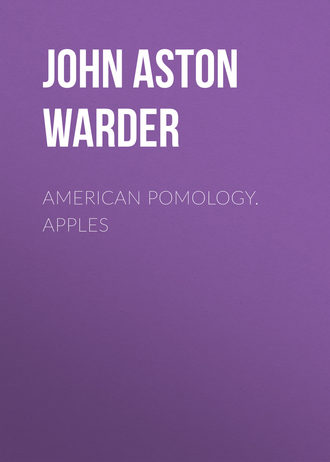 полная версия
полная версияПолная версия
American Pomology. Apples
A first rate southern fruit. Tree thrifty, and very productive.
Fruit medium, oblate, slightly conic, angular; skin yellowish, striped and mostly shaded with red, thickly sprinkled with whitish and bronze dots; Stem short and small, inserted in a broad cavity surrounded by russet; Calyx partially closed; Basin slightly corrugated; Flesh yellow, very tender, juicy, mild sub acid, excellent, highly prized in Georgia and the South; October and November. Carter of Alabama may prove the same.—[C. Downing.]
Melon
Fig. 133.—MELON.
Origin East Bloomfield, New York. Tree sufficiently vigorous, spreading, round-headed.
Fruit large, oblate, somewhat conical, angular; Surface smooth, waxen yellow, nearly covered with marbled and mixed scarlet, striped distinctly with darker shade; Dots minute.
Basin, wide, medium depth; Eye medium, open.
Cavity deep, acute, wavy, green and brown; Stem medium.
Core regular, heart-shaped, wide, partially open, clasping; Seeds numerous, medium, angular; Flesh yellow, tender, fine grained, juicy; Flavor acid, sub-acid, aromatic, rich; Quality almost best; Use, table, market and kitchen; Season, November to January.
MusterThis very nice apple was introduced to my attention by my very good friend Calvin Fletcher, Jr., of Indianapolis, in which neighborhood it grows. Its origin and history are unknown, nor do any satisfactory responses come to the oft-repeated question—What is this delicious apple?
Fruit large, oblate, angular; Surface yellow, mostly covered with mixed red and splashes of crimson; Dots scattering, large, yellow and gray.
Basin moderately deep, folded; Eye medium, open.
Cavity medium, regular, brown; Stem medium to short.
Core small, closed; Seeds plump, dark; Flesh yellow, fine-grained, tender, juicy; Flavor sub-acid, aromatic; Quality best for dessert; Season, August and September.
Pennsylvania Winesap.—[Local Name.]Origin unknown; Grown in Wayne County, Indiana.
Fruit large, conical-oblate, truncated, angular.
Surface smooth, yellow, blushed, very little splashed; Dots scattered, minute.
Basin medium, folded, wavy; Eye medium, closed.
Cavity medium, wavy; Stem medium or short, stout, fleshy.
Core regular, closed; Seeds few, plump; Flesh yellowish-white, tender, fine-grained, juicy; Flavor sub-acid; Quality good; Use, table; Season, December, January.
Wagener
Fig. 134.—WAGENER.
This beautiful and useful apple originated at Penn Yan, Yates County, New York; was described and figured in the Transactions of the State Agricultural Society.
Tree thrifty, upright, productive, and very early bearer.
Fruit large, oblate or globular-oblate, pentangular; Surface very smooth, yellow, well covered with mixed bright red, stripes not distinct; Dots scattered, yellow.
Basin wide, abrupt, regular; Eye small, closed.
Cavity regular, brown; Stem medium, green.
Core regular, wide, heart-shaped, closed, meeting the eye; Seeds numerous, large, angular; Flesh yellowish-white, tender, fine-grained, juicy; Flavor mild sub-acid; Quality good; Uses, market, table and kitchen; Season, November and December.
CLASS I.—FLAT APPLESORDER II.—IRREGULARSECTION 2.—ACIDSUB-SECTION 3.—RUSSETCranberry RussetThis apple was introduced to the notice of the Ohio Pomological Society by its Vice-President, J. Austin Scott, of Toledo, Ohio.
Fruit medium to large, oblate, flattened at the sides, irregular; Surface rough, russeted, blushed carmine, uneven; Dots numerous, large, gray, prominent.
Basin shallow, uneven; Eye small, partially open.
Cavity deep, acute, green; Stem long, slender, knobby.
Core wide, regular, closed; Seeds long, angular, brown; Flesh breaking, tender, not very juicy; Flavor quite acid; Quality second rate, but said to be superior for cooking; Season, November and December.
Roxbury RussetBOSTON RUSSET.—PUTNAM RUSSET
Fig. 135.—ROXBURY RUSSET.
This standard apple is perhaps as widely known and as much admired as any other in the catalogue. It was brought to the West by different routes—by the Ohio River and by the lakes—and has been universally distributed. Those brought to the mouth of the Muskingum River, and propagated by Mr. Putnam, had the name changed to that of the Marietta and the Putnam Russet; and at the same time the appearance of the fruit was so altered by increase in the russeting, that it was long thought to be a different variety, until the question was at length settled by interchange of grafts; and when these fruited the identity was proved.
It is claimed that more money has been realized from this than from any other variety, though, on the Ohio River, the Rome Beauty is considered to be equally profitable. The popularity of this Russet is on the wane, however, as it is very subject to attacks of the Codling-moth, which makes it fall, and because it is apt to ripen too early in the season in southern locations and on limestone soils. Hence its value as a keeping apple is diminished.
Tree robust, vigorous, spreading; Shoots stout, straggling, dark; Foliage gray-green.
Fruit large, oblate, often lop-sided at the West, frequently angular, sometimes conic and truncated; Surface overspread with heavy brown russet in the South, but green, often bronzed, and with partial light russet at the north of latitude 41°; Dots minute, scattered.
Basin regular or wavy, green, often folded; Eye medium, closed.
Cavity regular, pointed; Stem medium, curved.
Core regular, closed, clasping; Seeds numerous, angular, imperfect; Flesh greenish-yellow, breaking, granular, often coarse, juicy; Flavor decidedly acid; Quality second rate; Use, market and cooking; Season, November to January; a better keeper in the North.
Whitney Russet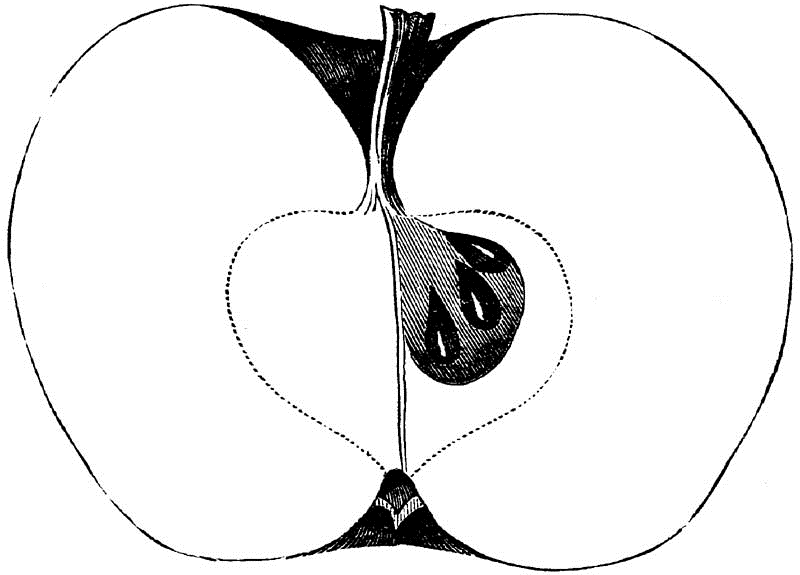
Fig. 136.—WHITNEY RUSSET.
Of uncertain or accidental origin in the extensive nurseries and orchards of my friend A.R. Whitney, of Franklin Grove, Lee County, Illinois, where my specimens and trees were procured.
Fruit medium or small, roundish-oblate, truncated, angular; Surface smooth, yellow, rather thinly russeted; Dots minute, prominent.
Basin abrupt, regular, green; Eye medium, closed.
Cavity acute, deep, wavy; Stem medium to long, slender.
Core medium, regular, heart-shaped, rarely open, meeting the eye; Seeds very numerous, medium, plump; Flesh greenish-yellow, breaking, very fine-grained, juicy; Flavor sub-acid, aromatic, rich, spicy; Quality best; especially a dessert apple; Season, December to February.
CLASS II.—CONICAL APPLESORDER I.—REGULARSECTION 1.—SWEETSUB-SECTION 1.—SELF-COLOREDLarge BoughLARGE YELLOW BOUGH, ETC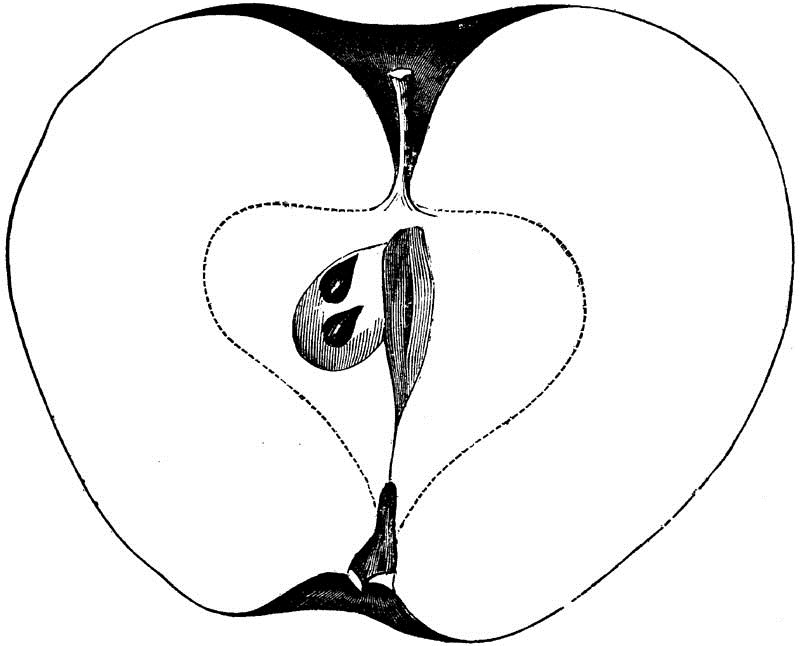
Fig. 137.—LARGE BOUGH.
A native fruit, much admired as an early sweet apple. Tree vigorous, compact head, rather productive.
Fruit round-conic, regular, very light; Surface smooth, white or pale yellow; Dots minute, dark, indented, few.
Basin rather shallow, regular; Eye small, closed.
Cavity acute, regular, deep, sometimes brown; Stem medium.
Core regular, nearly closed, clasping; Seeds medium, dark; Flesh white, very soft, light, juicy; Flavor very sweet when ripe, somewhat bitter when green; Quality only good—by some called best; Use, market, stock and dessert—tasteless when cooked; Season, July and August.
FallawaterTULPEHOCKEN, ETC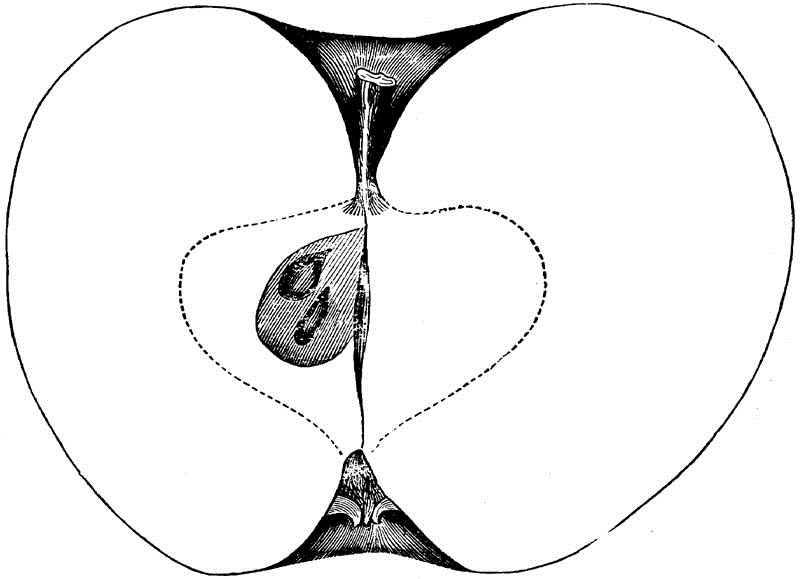
Fig. 138.—FALLAWATER.
A native of Pennsylvania, where it is a great favorite; extensively cultivated through the West.
This is essentially a market apple, having little to recommend it but its size, appearance and productiveness.
Tree very vigorous, spreading, productive, not long-lived; Shoots very stout, dark; Leaves large.
Fruit large, round or oblate-conic, regular; Surface sometimes smooth, greenish-yellow, often blushed crimson—large specimens covered with whitish veined marks; Dots numerous, gray, large, and having whitish bases.
Basin rather deep, regular; Eye large, open.
Cavity deep, regular, brown; Stem short, stout.
Core medium, closed, meeting the eye; Seeds numerous, angular; Flesh whitish, often greenish-white, light, tender, juicy; Flavor very mild sub-acid, or sweet, with little character; Quality scarcely good; Use, market and stock; Season, November, December, and may be kept longer if desired.
Michael HenryMICHAEL HENRY PIPPIN.—[Coxe.]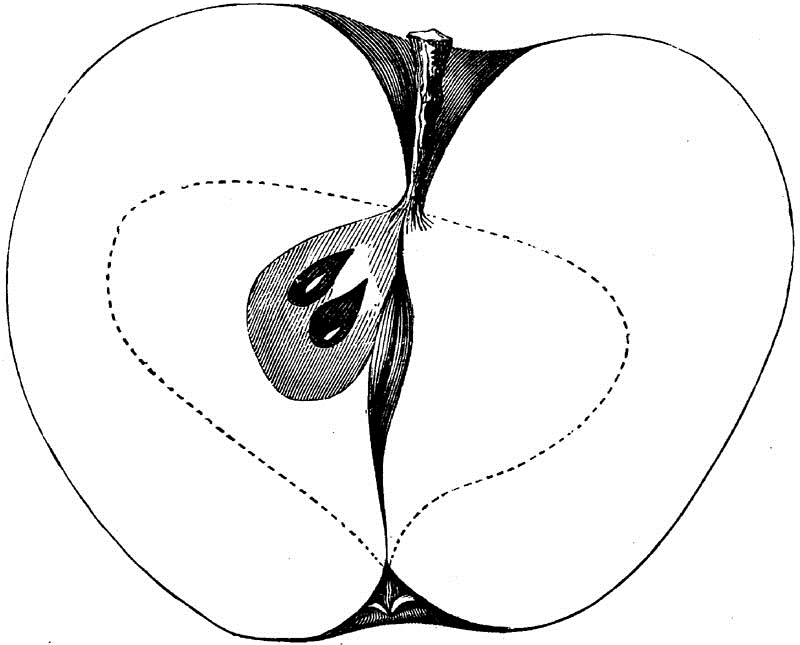
Fig. 139.—MICHAEL HENRY.
Origin Monmouth County, New Jersey. Extensively cultivated in the Western States, where it has many admirers.
Tree vigorous, not large, spreading, very productive, early bearer; Shoots dark, foliage medium and healthy.
Fruit fair, medium to large, conic, regular; Surface smooth, dull green, whitish stripes, pale yellow when ripe, rarely a faint blush; Dots scattered, prominent.
Basin abrupt, or shallow, regular; Eye medium, closed.
Cavity deep, acute, brown; Stem short to medium.
Core regular, heart-shaped, clasping, closed; Seeds numerous, plump, black; Flesh pale yellow, breaking, tender, light, juicy; Flavor sweet, slightly aromatic, little character; Quality good; Use, market, kitchen; Season, December and January; keeps well.
Premium of 1858
Fig. 140.—PREMIUM OF 1858.
Found in a seedling orchard near Springfield, Ohio, and awarded the premium in 1858.
Fruit medium, roundish-conic, regular; Surface smooth, pale yellow; Dots numerous, minute, white.
Basin shallow, regular, folded; Eye large, closed or open.
Cavity wide, shallow, regular; Stem long, slender.
Core rather large, regular, open, meeting the eye; Seeds numerous, angular; Flesh yellow, line grained, tender; Flavor very sweet, rich; Quality very good; Use, baking and stock; Season, October to December.
Shockley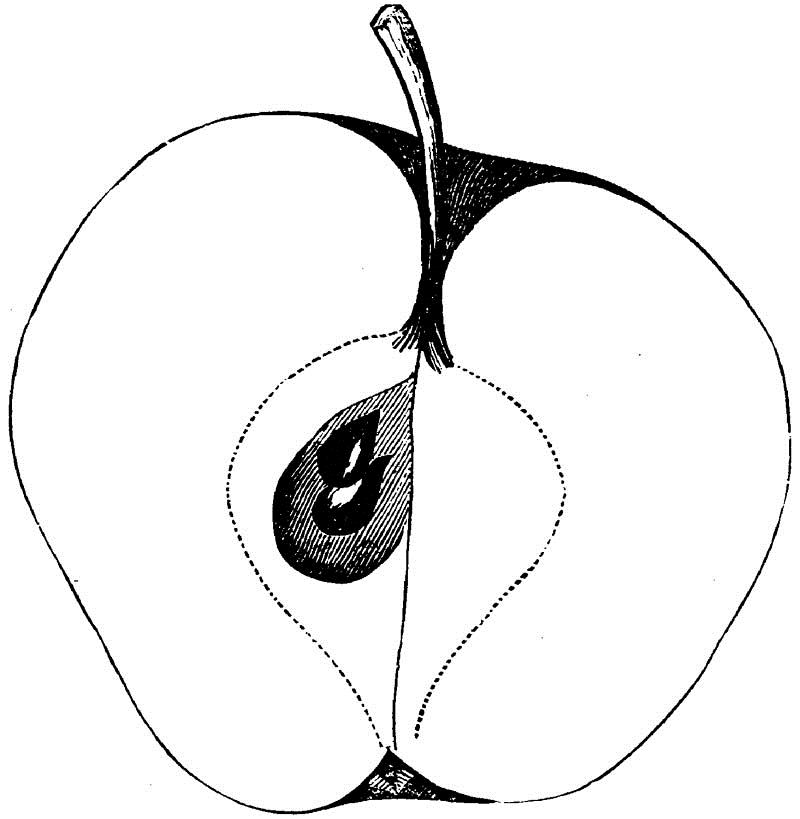
Fig. 141.—SHOCKLEY.
Origin Jackson County, Georgia. This long-keeper from the South promises to be an acquisition of value for market orchards, unless its small size may make an objection.
Tree vigorous, very productive.
Fruit medium to small, conic, truncated, regular; Surface very smooth, waxen yellow, marbled or blushed scarlet and crimson; Dots scattered, minute, gray.
Basin shallow, plaited; Eye small, closed.
Cavity acute, deep, regular; Stem slender, long. Core long heart-shaped, closed, meeting the eye; Seeds numerous, plump, dark; Flesh yellow, fine grained; Flavor mildly sub-acid, rich, saccharine, agreeable; Quality very good; Use, dessert; Season, March to June; a good keeper.
Sweet Pear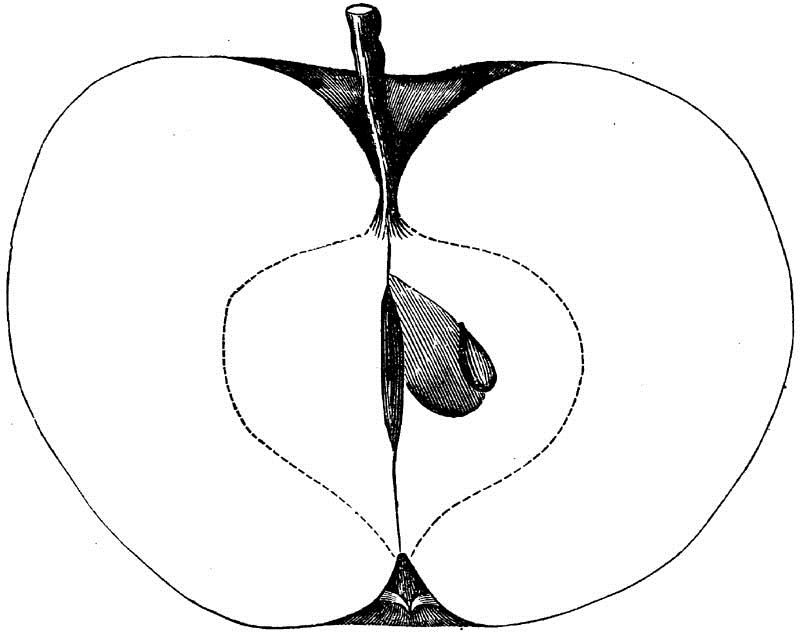
Fig. 142.—SWEET PEAR.
The origin of this fruit is uncertain; the specimens were obtained in the orchard of H.P. Kimball, and his father-in-law, Dr. George Haskell—zealous pomologists at Rockford, Illinois.
Fruit medium to large, round, somewhat conic, regular; Surface smooth, yellowish-green, blushed; Dots numerous, minute, gray, indented; red spots.
Basin quite shallow, plaited; Eye small, but long, closed.
Cavity deep, acute, wavy, green; Stem long, rather slender, green.
Core small, round, somewhat open, clasping the eye; Seeds numerous, medium, pointed; Flesh greenish-white, breaking, fine grained, juicy; Flavor sweet, aromatic; Quality good to best; Use, table; Season, October.
Victuals and DrinkGREEN SWEET OF INDIANA.—POMPEY.—FALL GREEN SWEET
Fig. 143.—VICTUALS AND DRINK.
This old variety has met with great favor in its western home, though not esteemed or much cultivated in the Eastern States, unless about Newark, New Jersey, where it originated about 1750, according to Downing.
Tree spreading, large; Branches twiggy, slender, moderately productive.
Fruit large, conical, regular, but uneven; Surface somewhat rough, dull green to dull yellow, often veined russet; Dots numerous, minute.
Basin medium, sometimes abrupt, regular or folded; Eye medium, closed.
Cavity wide, wavy, green; Stem short.
Core small, regular, oval, clasping, closed; Seeds numerous, angular, imperfect, dark; Flesh greenish-white or yellowish, very tender, fine-grained, light; Flavor very sweet, very rich; Quality best; Use, baking, table and stock; Season, September and October—in the North later, but is not a housing apple.
Virginia June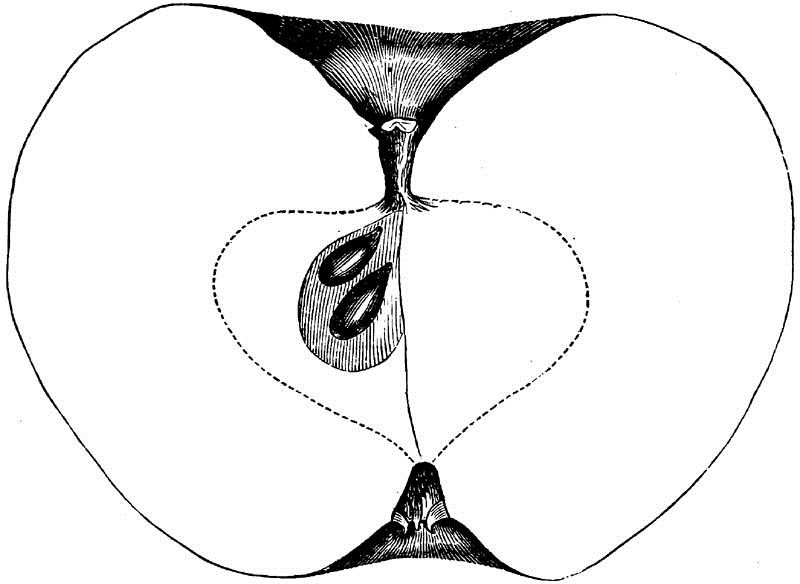
Fig. 144.—VIRGINIA JUNE.
Presented by W.P. Putnam, of Ohio, as brought from Adams County, Mississippi.
Fruit medium to large, oblate-conical, regular; Surface greenish-yellow; Dots scattered, prominent.
Basin medium, regular, abrupt; Eye medium, open.
Cavity very wide, regular, brown; Stem very short.
Core heart-shaped, regular, meeting the eye, closed; Seeds numerous, pointed; Flesh yellow; Flavor rich, sweet; Quality good; September to October, in Ohio.
This may prove to be some known variety, but it has not yet been recognized.
The Virginia June, grown in Kentucky and Indiana, is quite different, being round, striped and sub-acid. It is esteemed, where known, as a household apple, but becomes rather dry.
CLASS II.—CONICAL APPLESORDER I—REGULARSECTION 1.—SWEETSUB-SECTION 2.—STRIPEDKentucky Sweet
Fig. 145.—KENTUCKY SWEET.
This is an apple of Kentucky or southern origin, found in many parts of the western country among the emigrants from Dixie Land, with whom it is a great favorite on account of abundant fruitage and rich sweetness.
Specimens, under name, were received from the intelligent southern pomologist, J.S. Downer, of Fairview, Kentucky, also from J.W. Dodge, of Pomona, Tennessee, from which the description and drawing are taken. It has also been seen frequently in Southern Illinois.
Fruit medium, conic, regular; Surface smooth, deep red, stripes obscured and scarcely visible, the yellow ground color rarely seen; Dots scattered, large, yellow.
Basin regular, narrow, not deep, leather-cracked; Eye medium, long, open; Segments short.
Cavity acute, not deep, brown; Stem short to medium.
Core oval, regular, not meeting the eye, somewhat open; Seeds numerous, large and imperfect, brown; Flesh yellow, tender, fine-grained, juicy; Flavor very sweet, rich, slightly perfumed; Quality very good to best; Use, baking, market and stock; Season November to January. Keeps well.
MilamBLAIR.—(Rarely.)
Fig. 146.—MILAM.
This is another little southern favorite, to be found by almost every cabin in parts of the West. Whole orchards have been planted with sprouts from the mother trees, among the people to whom the art of grafting was an unheard of mystery. Now distributed by nurserymen all over the country.
Tree moderately vigorous, round-headed, twiggy; shoots reddish; foliage rather dark. Annually productive and an early bearer.
Fruit small to medium, conical, regular; Surface smooth, yellow, covered with marbled red, indistinct stripes; Dots small, gray, scattered, prominent.
Basin narrow, wavy, leather-cracked; Eye medium, closed.
Cavity regular, acute, brown; Stem long.
Core ovate, covering the eye, closed; Seeds numerous, some imperfect; Flesh white, tender, crisp, juicy; Flavor mild sub-acid or sweet, agreeable and refreshing, but without any decided character; Quality good; Use, dessert, in cooking it lacks flavor; Season, December, January.
CLASS II.—CONICAL APPLESORDER I.—REGULARSECTION 1.—SWEETSUB-SECTION 3.—RUSSETPumpkin SweetSWEET RUSSET, of OhioFruit was exhibited at the Ohio State Fair at Zanesville.
Fruit large, regular, roundish, conical; Surface dull green, covered with a rough coat of russet.
Basin medium, regular; Eye medium, closed.
Cavity deep, narrow, regular; Stem long, slender.
Core medium, regular; Seeds numerous, small, plump; Flesh spongy, light; Flavor sweet; Quality scarcely good; Use, baking, stock; Season, autumn.
This apple has never commended itself very highly to my notice in the limited opportunities I have had for its examination, but it is esteemed in some parts of the country for baking and for stock-feeding.
CLASS II.—CONICAL APPLESORDER I.—REGULARSECTION 2.—SOURSUB-SECTION 1.—SELF-COLOREDAugust Tart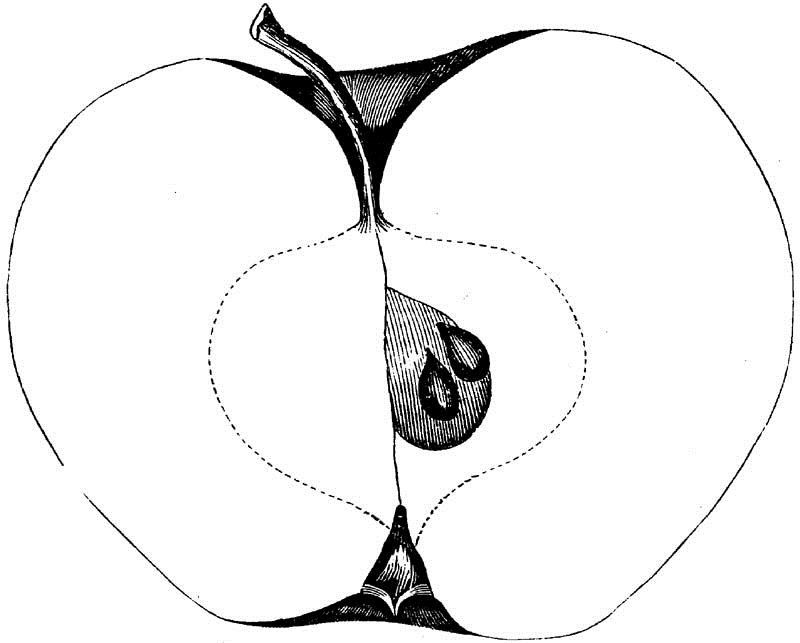
Fig. 147.—AUGUST TART.
Origin unknown. Specimens procured from Marietta, Ohio.
Fruit medium to large, regular, conical, truncated; Surface smooth, yellow-green; Dots numerous, large, yellow.
Basin medium, wavy or folded; Eye medium or small, closed.
Cavity wide, regular, brown; Stem long, slender.
Core medium, regular, closed, clasping; Seeds numerous, pointed; Flesh greenish-yellow, breaking; Flavor acid; Quality poor, except for cooking; Season August.
DemocratOrigin unknown. Specimens obtained from George Powers, of Perrysburgh, Ohio.
Fruit medium, handsome, roundish-conic, regular; Surface yellow, blushed scarlet; Dots minute, indented.
Basin shallow, regular; Eye small, closed.
Cavity rather deep, very acute; Stem medium to short, slender.
Core heart-shaped, rather open, meeting the eye; Seeds large; Flesh yellow, breaking, juicy; Flavor sub-acid, aromatic, rich; Quality good to very good; Use dessert; Season October to December.
Holland Pippin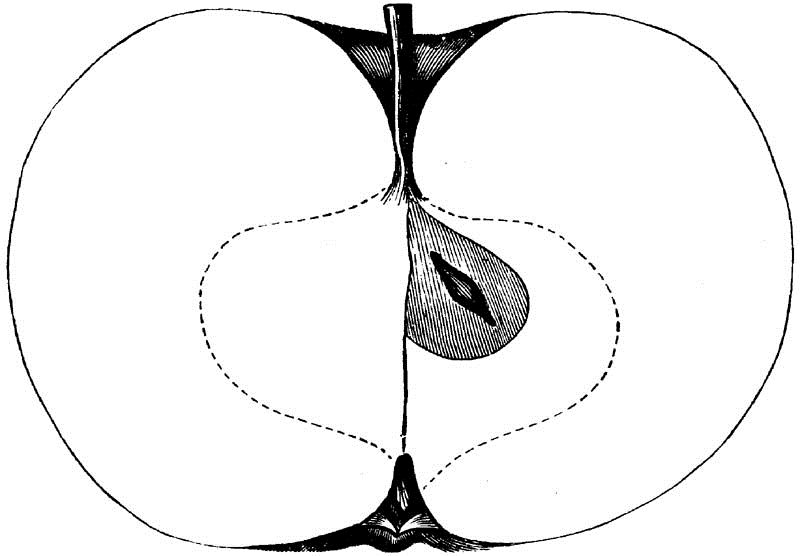
Fig. 148.—HOLLAND PIPPIN.
There is a strange confusion existing in some of the books, by which this fruit has been associated with the Fall Pippin. The Holland, as grown in Western New York, and through the West, as derived from the former State, is entirely different; and as that is extensively known, its description is here given, that it may be compared with the other, which belongs to a different class.
Fruit large, regular, conic, rather oblate; Surface dull yellowish-green, rarely bronzed; Dots minute.
Basin narrow, medium depth, regular; Eye medium, closed.
Cavity medium, acute, regular, brown; Stem medium to long.
Core medium, regular, closed, meeting the eye; Seeds numerous, sometimes imperfect; Flesh yellowish-white or greenish-white, breaking, coarse-grained, juicy; Flavor quite acid, not rich, not agreeable; Quality only fair; Use cooking only; Season, October to December at the North. Not seen in the southern counties of the States north of the Ohio River.
Middle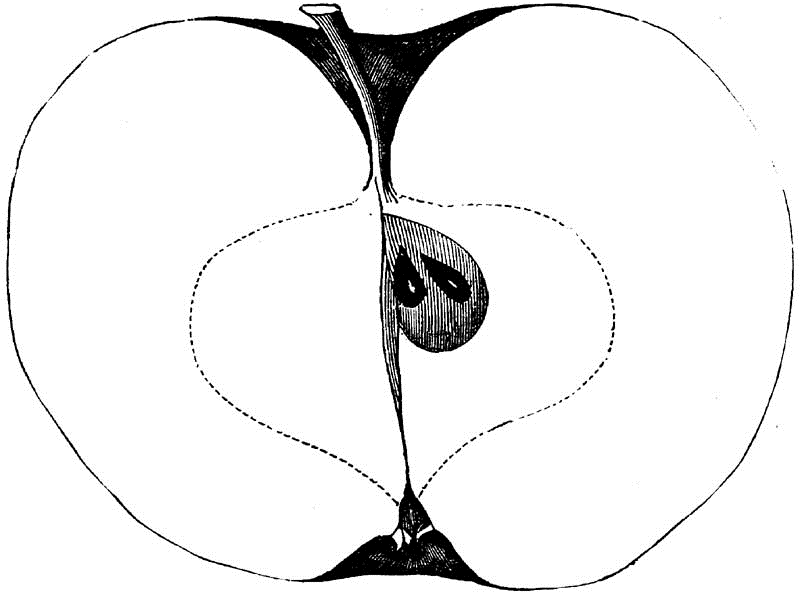
Fig. 149.—MIDDLE.
A comparatively new fruit, from Herkimer County, New York, found in a division fence between two neighbors; hence its name. Considerably cultivated in the neighborhood, where it is highly esteemed. Introduced into Ohio by Mr. John Ludlow, of Springfield, in 1854, and propagated at the Oakland Nurseries near by.
Tree thrifty and productive.
Fruit medium to large, conical or oblate-conic, regular; Surface rather smooth, green to pale greenish-yellow; Dots small, irregular, rather abundant, gray, somewhat prominent.
Basin shallow, nearly regular, russeted, like Rhode Island Greening; Eye small, closed.
Cavity acute, sometimes lipped, wavy; Stem long, slender.
Core small, oval, regular, closed, just meeting the eye; Seeds small, very light colored; Flesh greenish-yellow, breaking, fine grained, tender, juicy; Flavor sub-acid, rich, aromatic; Quality nearly first rate; Use dessert; Season December and January, but is said to keep until May in New York.
White Winter Pearmain
Fig. 150.—WHITE WINTER PEARMAIN.
This favorite fruit was brought to Indiana by some of the early pomologists, in the days of saddle-bag transportation. In a lot of grafts, two varieties, having lost their labels, were propagated and fruited without name. Being considered Pearmain-shaped, they were called respectively Red and White Winter Pearmains. The former proved to be the Esopus Spitzenberg; the latter has never yet been identified, though believed to be an old eastern variety. Mr. Downing suggests that it may be Winter Harvey, a description of which I have not seen. At one time this apple was confounded with the Michael Henry by many of us, and Mr. Elliott gives it as a synonym of that variety, but they are very distinct.
Tree spreading, vigorous, productive, the bark often marked by a kind of canker or crack. Foliage large, rather light green.
Fruit medium to large, handsome when fair, but often scabby on rich limestone soils and on old trees, conical, regular, sometimes obscurely angular; Surface smooth, yellow, often bronzy; Dots scattered, small, dark.
Basin abrupt, regular or shallow and folded; Eye medium, closed.
Cavity acute, wavy, brown; Stem medium to long, often knobby and clubbed.
Core regular, closed, slightly clasping the eye; Seeds few, pointed, pale or yellow; Flesh yellow, fine grained, tender, crisp, juicy; Flavor mild sub-acid, very rich; Quality best; Uses table, kitchen, market; Season December to March.
WoolfolksThis is supposed to be a Kentucky seedling. It was received from my friend Ormsby Hite, of Louisville.
Fruit full, medium, truncated, regular; Surface very smooth, yellow-green; Dots scattered, gray, white bases.
Basin medium, wavy, plaited; Eye small, closed.
Cavity wide, acute, wavy, brown; Stem short, green.
Core small, heart-shaped, regular, closed, clasping; Seeds pointed, angular, dark; Flesh white, tender, breaking, juicy; Flavor sub-acid; Quality good; Use, table, kitchen; Season, December to March.
CLASS II.—CONICAL APPLESORDER I.—REGULARSECTION 2.—SOURSUB-SECTION 2.—STRIPEDAlexanderThis Russian apple, so much admired for its size and beauty, is not a favorite in the orchard, though some persons have found it profitable in the markets.
Tree medium size, spreading, moderately productive, early bearer.
Fruit large to very large, fair and handsome, conical, truncated, sometimes obscurely angular; Surface smooth, pale yellow, striped and splashed distinctly bright red, sometimes shaded mixed red; Dots minute.
Basin medium, regular; Eye small, long, closed.
Cavity rather deep, narrow, regular, brown; Stem medium to short, stout.
Core wide, regular, nearly closed, clasping; Axis short; Seeds large; Flesh whitish, breaking, not fine grained, juicy; Flavor acid, not rich; Quality scarcely good, except for cooking; Season, August and September. Fruit falls badly from the tree.
Cayuga Red StreakTWENTY OUNCE, ETC
Fig. 151.—CAYUGA RED STREAK.
I have preferred to adopt the above name for this old Connecticut apple, to avoid the confusion arising from another and very indifferent fruit that is still considerably cultivated upon the same parallels with this, and known as the Twenty Ounce Pippin.
The Cayuga is a very great favorite as a market and family fruit in many parts of the country north of latitude 40°—being large, handsome and productive.



